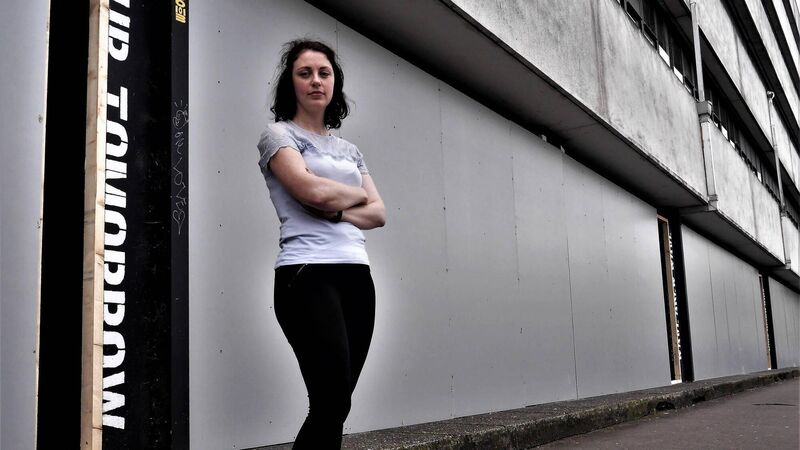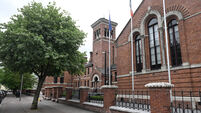Cork art groups are struggling to find new homes as property prices rise


Stevie was one of the people behind the final incarnation of The Pavilion, a noted Cork music venue that had hosted gigs by Franz Ferdinand, Laura Marling and even Kanye West. Its abrupt closure two years ago left a gap in terms of mid-sized music venues in the city that has yet to be filled, but Stevie says that closures like The Pavilion and Plug’d records are emblematic of the problems faced by all the arts disciplines in the city.

With the plans for an Events Centre at the former Beamish and Crawford brewery site on hold yet again, despite public funding of €20 million having been ringfenced for the development, it’s currently unclear as to what the extent of the potential for arts uses will be when the building is completed.
FOR six years, the old FÁS office on Sullivan’s Quay served as artists’ studios, under an agreement with developers BAM Ireland.
The arrangement began in 2011 when a group of third-year students from the Crawford College of Art and Design held their end of year show in the vacant quayside office block.
A large and vibrant community emerged, and the building was also used for theatre development, offices for the IndieCork Film Festival and as a venue for performances and screenings.
With BAM due to demolish the structure and build offices and a hotel on the site, and with a scarcity of other suitable buildings in the city centre, the collective known as Sample Studios has temporarily moved to Churchfield.
The move hasn’t been easy, director Aideen Quirke says: “We had 86 artists spread over three floors in that building and not all of them have been able to move with us; we have 30 now, and 20 non-studio members. All of those associate members are waiting for us to try and find a city centre space.”
Aideen sees the experience of the Sample Studio artists as part of “a gentrification process,” whereby arts and culture endeavours make an area attractive, increase the value of property and then the artists get moved on when more lucrative uses are found for the cheap spaces they’ve been occupying.
“Artists have to be immunised against the fluctuations of market or the same thing happens over again,” she says.
“We go into dilapidated buildings and do them up, and then suddenly it’s, ‘ok, this is a cool area now and a Starbucks or a doughnut shop is going in.’” Sample Studios are still searching for a suitable building in the city centre. “We can’t afford the same rates as commercial,” Aideen says.
The new proposed 220-hectare docklands development that could see the size of Cork doubled has the potential to embed arts spaces in new communities.
“There has to be a provision for arts, music, culture and heritage,” she says.
“For every building that gets knocked down and artists shoved out, there has to be something retained; a physical space that can’t be taken back, a cultural space, and that’s down to strategic planning and policy making. When all the power is with the developers, they don’t care.”

FORCED to close their doors not once, but twice, The Camden Palace Community Arts was home to 22 artists’ studios when the arts centre was housed in the former Atkin’s Garden Centre on Camden Quay.
Creative resources available to the public in the landmark 28,000 sq ft building had included a photographic darkroom, theatre, dance studios, exhibition spaces and 22 studios, and the centre was holding over 1,000 cultural events annually until the building was sold for conversion into 65,000 sq ft of offices by Stone Work Properties Ltd.
Nine artists moved their studios to a former dental surgery on nearby John Redmond Street, where facilities were much smaller. But that too is due for development, as offices and apartments, and the Camden Palace arts group shut their doors amidst pleas to City Council to help house their group.
They are still looking and despite their members being dispersed, would like to form new studios, Camden Palace board member Dave McCarthy says.
“The artists are now scattered around the city, over shops and restaurants in tiny studios, or with nowhere to practice,” Dave says.
“We’ve lost a huge number of people and we lost a a real community that supported each other, motivated and helped each other, and encouraged each other to be a bit more ambitious.” Cork City Council haven’t responded to Camden Palace representatives’ requests for assistance, and Dave believes that the solution may be more likely to be found in private, commercial patronage rather than public assistance.
But he says that whatever the future, there needs to be a recognition and respect for the place of creative endeavours in Cork’s society.
“Artists have every bit as much right to talk about how the city is going to be shaped as architects and business interests, not only for their own needs as artists but also to share their vision for Cork,” he says.
“People very often forget how much our country owes to creative minds, poets, dreamers, people who imagined a future Ireland back in 1916. It’s not possible to reap that legacy from this generation of artists unless there’s help from the people who have their hands at the helm of where the city is going.”

ANOTHER Cork culture-maker impacted by multiple closures, Caoilian Sherlock was working at The Pavillion when the venue shut its doors in 2014.
He and colleague Aisling O’Riordan quickly began arranging venues for the acts left short a Cork gig date by the music institution’s abrupt closure.
“It was a decision led by our hearts, rather than by our minds or our pockets,” Caoilian says.
“We couldn’t see where those shows would happen, and we were afraid that if we didn’t do it, no-one would.” They became Southern Hospitality Board and specialised in booking and events management, before also getting involved in organising hip young emerging arts festival Quarter Block Party, which is now in its fourth year.
Southern Hospitality Board announced they were taking a break from their bookings six months ago.
Caoilian cites the difficulty in finding suitable venues as one of the pressures faced by the partnership.
The closure of The Kino, which was in use as a multi-purpose venue up until April’s sale of the building to an unknown purchaser, is a case in point; as a cheap venue serving the needs of young and experimental acts and collaborations, Caoilian says it was filling a vital niche in Cork’s arts landscape.
Caoilian is troubled by the future for performing arts in Cork, not on a larger, commercial scale, where punters’ desires to see large international acts will be served by a completed Páirc Uí Chaoimh and the much-anticipated events centre at the former Beamish and Crawford site, but for young people who need to cut their teeth as musicians and need easy access to venues and practice spaces of a scale to accommodate them:
“Where does the next person who wants to play Páirc Uí Chaoimh come from?” he says.
“An 18-year-old girl or guy needs somewhere to go play the guitar and scream their head off; there’s nowhere for that to flourish. What’s important is that young people in this country get to have a stage or get to see a stage in front of them, and feel it’s a tangible thing for them to go and do something.” “The big question is: is art worth it? Is music worth it? People need to ask themselves if they want to live in a city with the facility for arts and culture or not, because that’s what’s happening now; they’re being taken away.”

CORK Community Printshop, tucked away behind Parnell Place, closed its doors a year ago following an inspection by Cork City Council’s fire officer.
It had been serving as a band rehearsal space, gig venue and artists’ studios for two years; unapologetically underground, their gigs tended towards punk and metal, with Siobhán Brosnan organising techno nights. Karol Lapot opened the Cork Community Printshop in 2013.
“We had over 40 gigs, and these were bands that wouldn’t have otherwise had anywhere to play; they’d be touring bands that mightn’t have been able to afford the deposit on a room,” Karol says.
“Here they could just come along, and everyone did everything for free. There were no overheads, so bands could come in and take what they took on the door. But we were all a bit naïve, I think.” Like many others, Karol thinks that increasingly monetised space squeezes out many rich cultural offerings where the rewards are not measured fiscally: “If there’s no profit to be had, it won’t be taken seriously.” The printshop organisers were told that complaints had been made not only about the safety of the building, but also about its use as a venue.
“I think publicans were worried that we were stealing their crowd, but that crowd doesn’t go to their pubs regardless,” Siobhán Brosnan says. “This was a space you could go to and have a cup of tea or a couple of cans, and it was affordable and there was a sense of belonging.” The printshop was also home to a regular swap-shop, a weekly vegan meal for 25-30 and numerous other collaborations.
“The whole idea was that everyone could work off each other,” Siobhán says.
“So there were bands practising here and they could get their artwork done by the artists in the studios and they could use the printshop to print up t-shirts as well, so everyone was very much working together and it was a bit of a melting pot for ideas.” “We wanted it to really be people who were there for the music; just a space to listen to this kind of music that wasn’t revolving around drink,” Siobhán says.
“We did some pre-parties before club nights where we had international DJs in the printshop.”







 App?
App?





